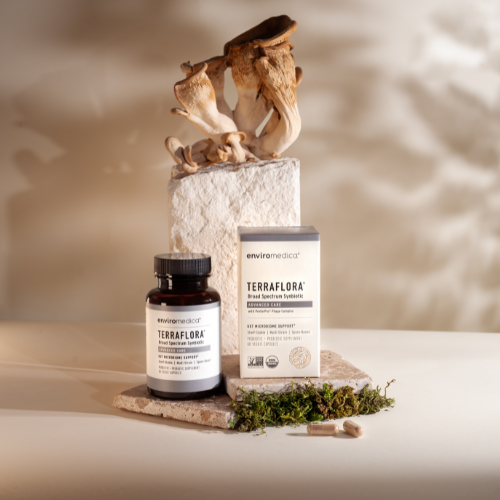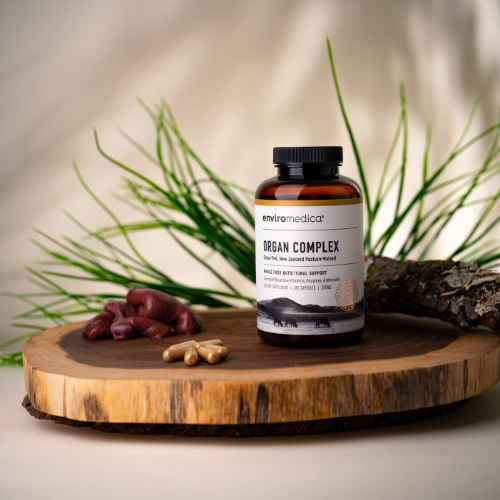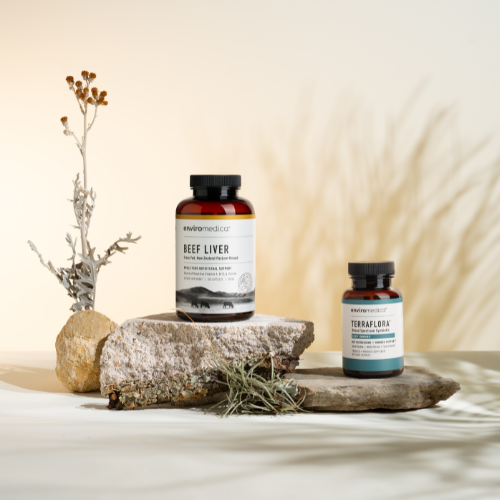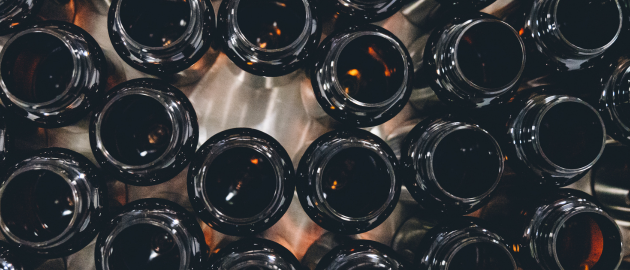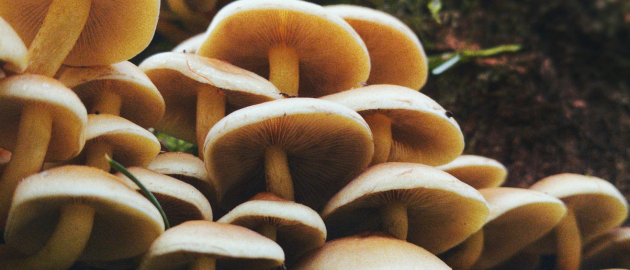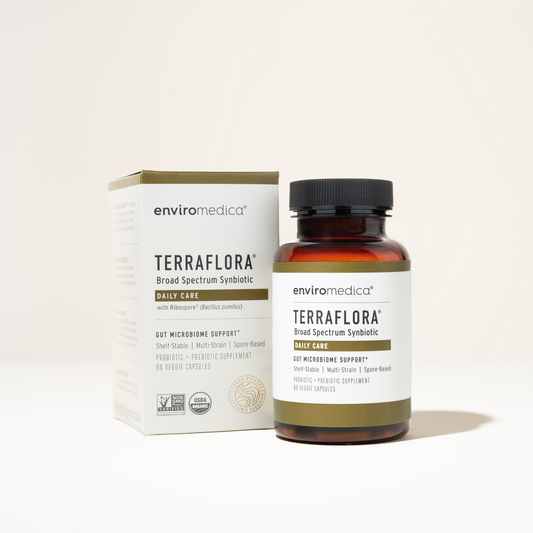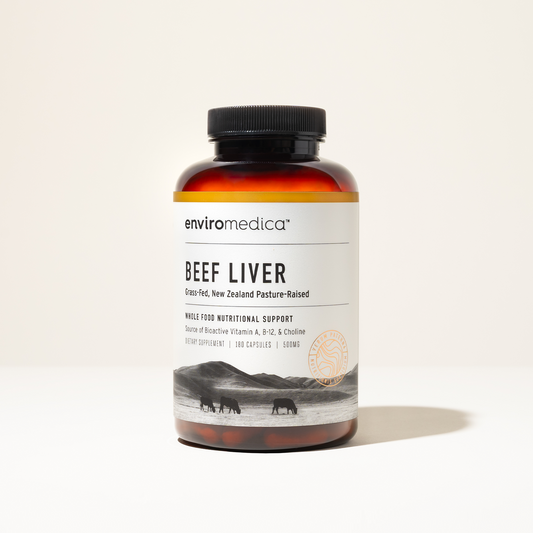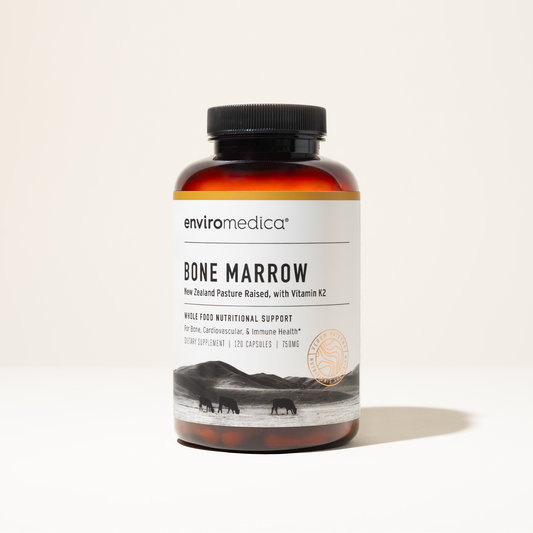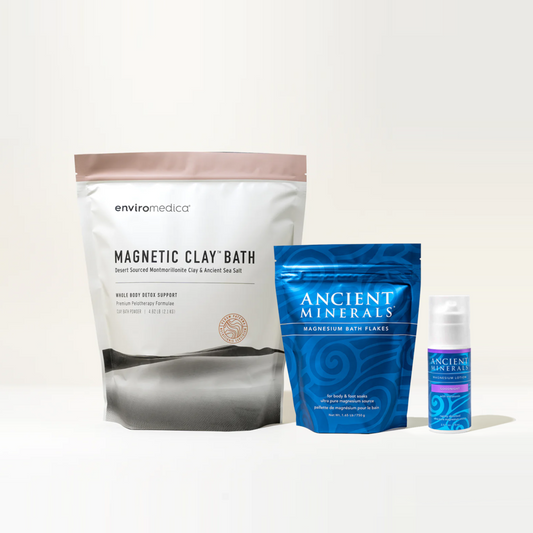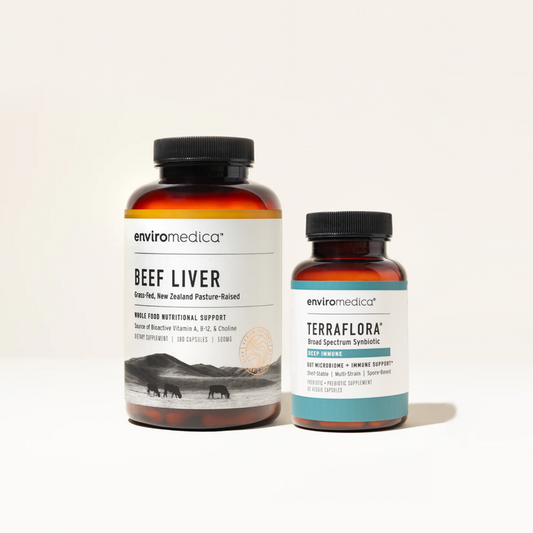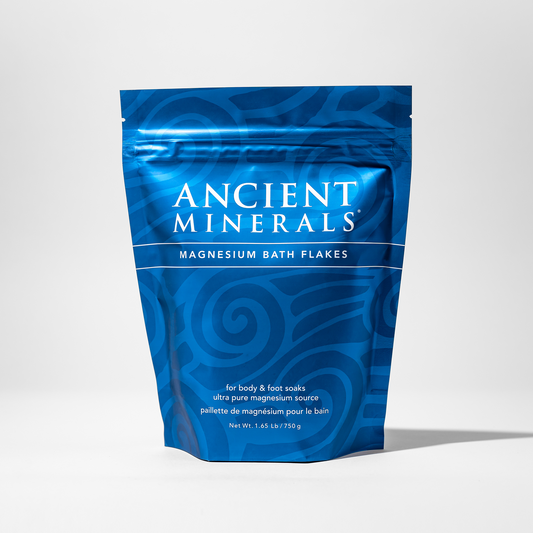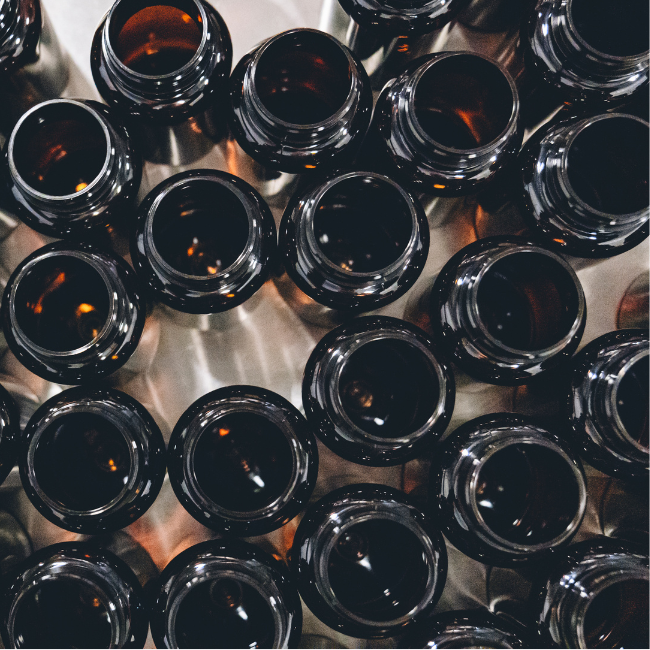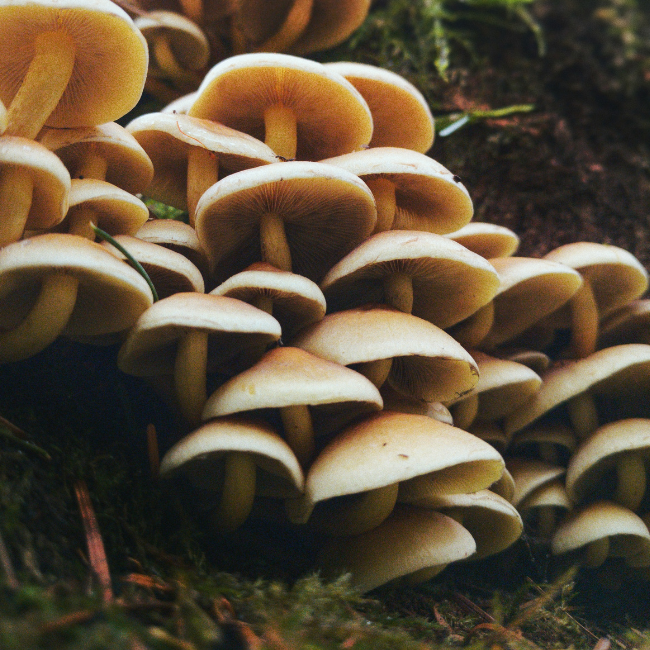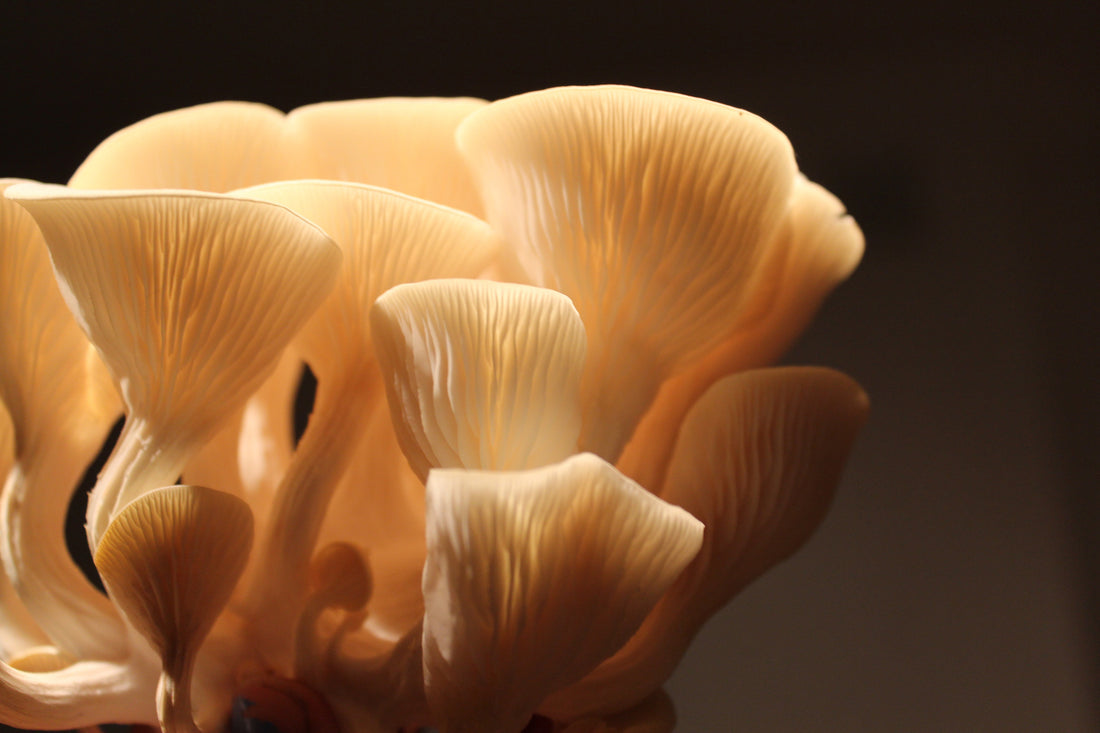Prebiotics
Prebiotics are what we label nutrients that bacteria feed on. Whether it is in the soil or in the human gut, delivering nutrients specifically to bacterial communities enables them to grow abundant and provide more nutrients to their host environment, creating a positive feedback loop of health.
If you’ve ever tended a garden, you understand the benefits of feeding the soil. Healthy, disease-resistant veggies depend upon biological information available to them. Soil is rich with diverse microbial and fungal communities that create nutrients and the ideal conditions for seeds to grow. Soil ecosystems enable root systems to propagate and stabilize the living substrate. The stable, naturally porous system is the perfect place for water to infiltrate to feed the soil ecosystem, promoting aggradation of the soil layer itself. Microbes feast on organic material in the soil, creating a substance that we’ve labeled ‘humus’. This positive feedback loop is inherent in nature and when we support living soil in our own backyard (think compost), we reap the delicious rewards.
There is an evolutionarily deep and very real analogy between soil ecology and human gut ecology.1 2 3 In a process known as convergent evolution, the epithelial microecology of the human gut is eerily similar to the epithelial microecology of root systems; nature knows how to break down substrates and exchange nutrients on a cellular level.
Our understanding of the importance of microbial ecology is nearing a tipping point in both agricultural and human health settings. As we learn that the key to growing food from the Earth without depleting or eroding the soil is to cultivate diverse soil microbial communities,4 5 6 7so to do we learn that the key to maintaining human health without depleting nutrients or eroding our gut integrity and immune system is to cultivate a rich and diverse gut microbiota.8 9 10
With that as a foundation, you might wonder how to tend the microbial community of your gut. Why does this matter to me? What prebiotics do our gut bacteria feed on? Why might we want to look to our ancestral ecosystem for prebiotics? Read on for more insight into your role in the delivery of prebiotic nutrients to your gut.
Species Abundance: Why Prebiotics Matter
Ecologists use biodiversity metrics of species diversity and richness to describe how well suited an environment is to supporting life. These metrics refer to the number of different species and the abundance or evenness of all species in that community. With this in mind, there is emerging understanding that a healthy gut microbial community is not only a diverse community, but an abundant one. This is discovered not only by analogy with ecosystem analysis as a whole, but from study of gut communities and their impact on their host directly.
Researchers have discovered that it is not simply the presence of bacteria in the human gut that is beneficial, but the metabolic actions of those bacteria. Bacteria secrete metabolites as they are nourished in the gut environment. These metabolites, whose genetic composition is collectively known as the secretome, have been shown to:
- aid in digestion of food
- lower cholesterol in the blood
- fight pathogenic bacteria and parasites
- lower blood pressure
- provide nutrients such as B vitamins and short chain fatty acids to the host
- control intestinal pH
- influence energy utilization
- improve gut motility
- induce apoptosis
- play a role in epigenetic modification
- improve gut barrier integrity
- include neurotransitters
- support the immune system11
These powerful bacterial metabolites are enabled to multiply when bacteria have access to food that nourishes them, or prebiotics.
Prebiotic Nutrients
There is a wide range of nutrients that bacteria feed upon. Odds are, your very first meal outside the womb included some of the most important prebiotic nutrients. It may seem obvious, but microbes that live in your gut have access to the food that you eat. Perhaps less obvious is that in the absence of dietary prebiotic nutrients (malnourishment), microbes may turn to host-secreted ‘nutrients’ upon which to feast.
If we are to parse them down to specific compounds, simple prebiotics include compounds like inulin, fructooligosaccharides, galactooligosaccharides, isomaltooligosaccharides, and Mannan oligosaccharides. More complex prebiotics include pectins, breast milk, resistant starch, and arabinoxylan.12 13 14 15 Essentially, these are carbohydrates found in plant and animal-based (mammalian milk) whole foods. Foods rich in indigestible dietary fiber that bacteria can ferment, such as fruits, onions, leeks, garlic, asparagus, artichokes and many, many others.16 17
About that first meal, if you were breast fed as a baby, then you received your first prebiotic on the day you were born[i]. The bacterial community that populates the gastrointestinal tract of a newborn is largely a result of the exchange of microbes with mom both via mode of delivery and subsequent mode of feeding. Infant microbial communities vary between babies born vaginally and those via C-section.18 It is hypothesized that babies born vaginally are inoculated with species that subsequently shape a stronger immune system.19
The dominant microbes in the infant gut community also vary between babies exclusively breastfed and those who are supplemented with formula. Breastfed babies that were supplemented with formula have microbial communities that are more similar to exclusively formula fed babies than those exclusively breastfed.20
Perhaps exclusively breastfed babies have such a distinct gut community because breast milk contains a natural prebiotic known as human milk oligosaccharide (HMO) that is delivered to the baby with abundant probiotic species making breast milk functionally a synbiotic. HMO is a complex sugar upon which beneficial bacteria feed and subsequently multiply in numbers. As such, breastfed babies are nourished in a way that begins to naturally shape their immune response, aid in the control of pathogenic bacteria, and assist in gut barrier function.21 22
It is clear that our disconnect with nature has shaped the western human gut in unnatural ways promoting discomfort and disease. Specifically, the foods we collectively choose to eat today do not resemble the foods that shaped our species. Low-diversity sugar-rich industrial foods in concentrated amounts with additives and preservatives are a far cry from the foraged plants and wild game diets of our ancestors.
With this disconnect in mind, Sonnenburg and Sonnenburg (2014) wrote a paper entitled: Starving our Microbial Self: The Deleterious Consequences of a Diet Deficient in Microbiota-Accessible Carbohydrates.23 Here they contribute new terminology to the world of prebiotics coining the phrase ‘Microbiota-Accessible Carbohydrates’ or MACs to be used in lieu of less functionally specific ‘dietary fiber’. They caution that the modern diet very low in MACs results in gut dysbiosis as it selects for microbes that are incompatible with the health of the host. They hypothesize that a lack of dietary MAC may lead the microbes in residence to nourish themselves on host-derived MACs found in the mucosal intestinal barrier, functionally depleting gut mucous and decreasing the intestinal barrier function. In other words, what the host doesn’t provide them, they cannibalize from the host.
The investigators point out an interesting estimate: that in a model of a gut community with roughly 1000 different species there might be more than 60,000 carbohydrate-degrading enzymes available to the host via its microbes. Compare that to the number of carbohydrate-degrading enzymes represented in the human genome alone about 17 glycoside hydrolases (enzymes capable of breaking bonds of complex sugars) and zero enzymes that can break down polysaccharides.24 That’s microbes:60,000+, humans:17. This not only highlights an important role that our bacterial residents play in the human digestive process but that these carbohydrates are more food for our bacteria than direct nourishment for us.
Human microbial ecology is complex and our understanding of this system is in its infancy. Suffice it to say that we play the ultimate role in maintaining the health of our gut communities. We can choose to provide our resident bacteria with food they recognize and reap the benefits, or novel foods they are unfamiliar with, and pay the consequences. A diet rich in whole foods (and poor in industrial foods) will go a long way toward achieving sufficiency in ‘microbiota-accessible carbohydrates’.
But one has to wonder, if we restrict ourselves to the whole foods that are available in the market today, are we limiting the bacteria that we nourish in our guts? We know that western guts have lost biodiversity across several generations due to diet and lifestyle.25 26 27 28
Did we kill bacteria with pharmaceuticals? Did we isolate ourselves from them by moving indoors? Or did we just starve them? Probably yes on all fronts.
[i] Unless we discover more about the potential in utero colonization of a prenatal microbiome29 30
Ancestral Prebiotics
Today, humans cultivate as little as 0.067% to a more liberal estimate of 0.5% of all edible plant species on Earth.31 32
In other words, the plant-based whole foods that are conventionally available to us clearly represent a very small fraction of prebiotic foods likely to have been enjoyed by our ancestors. We are literally missing out on a world of dietary possibility today.
Just as our gut microbes may be starved and ultimately decreasing nutrients available to us, conventional farming practices unnaturally modify soil ecosystems to increase crop yield ultimately depleting available nutrients to the plants.33 34
What can you do with this information?
You can consider prebiotics from an evolutionary perspective to leverage novel foods for your primal microbes AND discover micronutrients that may be missing from your current diet. Consider the following ancestral prebiotics: humic acids, larch, chaga, and seaweed.
Humic acids
Humus is what we call organic matter in the soil that results from physical, chemical, and microbial decay of once living organisms. Humic acids are natural compounds derived from humus; essentially weathering products and microbial metabolites. Roughly 80% of carbon in the soil and 60% of carbon in aqueous environments is in the form of humic acids.35
Humic acids have a long history of use as a soil supplement and have been the subject of more recent investigation for their antioxidant, anti-inflammatory, antiviral, and immune stimulatory properties.36 37 38
Humic acids also have intriguing bioremediation properties, by chelating heavy metals from contaminated soil.39 40
Interestingly enough, there are many studies on the positive health benefits of humic acid supplementation on commodity chickens. This makes sense when you put the natural environment of the chicken into context: they naturally free range and are generally immersed in the soil as a function of eating plants, insects, and small animals all day. A diet supplemented with humic acid was shown to increase intestinal viscosity, improve leaky gut, and decrease ammonia excretion in chickens.41
A small study of humic acids supplementation on humans showed that they have a prebiotic effect on gut microbiota. 14 healthy people took a humic acid supplement each day for 45 days. Their gut microbiota were measured via fecal samples provided a week prior to supplementation, on days 10, 31, and 45. It was discovered that the concentration of pre-existing microbiota in the colon measured at day 10 of supplementation increased from 20% over baseline to 30% over baseline by day 31. While no new species were introduced, the humic acid supplementation had a community boosting effect.42
Ancestrally, there can be no doubt that humic acids were an indirect part of the human diet. Food from the soil and with the soil was the rule, while today it may only be a minor part of the diet. You might ingest humic acids if you cultivate a backyard garden, support a community farm, or forage directly from your ecosystem. While researchers begin to shed light on the relationship between the role of the human (and therefore its gut) in our ecosystem by studying soil based organisms in and around us, 43 44 45 it appears that humic acids in the soil feed microbes, and therefore the soil itself is effectively a synbiotic
Larch arabinogalactan
Arabinogalactin is a complex carbohydrate and non-starchy polysaccharide characterized as dietary fiber. It has been discovered in the primary and secondary plant cell walls of medicinal herbs, in the seeds, fruits, leaves, and roots of vegetables, and in sap.46
Arabinogalactan has been found to:
- boost immune function, decreasing incidence of common cold by 23%47
- promote the production of short chain fatty acids
- decrease the production of ammonia48
- stimulate natural killer (NK) cell cytotoxicity49
- inhibit metastasis of tumor cells to the liver50
- protect white matter injury in the brain51
- boost gut microbial populations as a prebiotic 52
The arabinogalactan compound is abundant in plants of the genus Larix. The North American Larch tree is an arabinogalactan source used for commercial applications53 54 In addition to all of its other health benefits, this compound is a natural food source for beneficial bacteria.
Chaga
Chaga (Inonotus obliquus) are traditionally medicinal mushrooms found growing as fungal parasites on birch, alder, elm, and beech trees in northern latitudes.55 Chaga looks like a mass of charcoal on the bark of a tree, it invades the tree at wounds or broken branches and can actively decay a living tree for decades before the tree dies. This charcoal mass is part of the mycelium of the fungus. The fruiting bodies occur underneath the bark in areas of the tree that are no longer living.56 Active polysaccharides in the fruiting bodies of mushrooms, such as chitin, hemicellulose, a-glucans, mannans, xylans, and galactans classify them as nutrients for gut microbiota – or prebiotics.57
Chaga in particular contains a compound called betulinic acid that is found to have anticancer and anti-tumor properties. It triggers a mitochondrial pathway that causes cancer cells to die.58 Traditionally, it is steeped in a tea to treat a wide range of conditions from gastrointestinal to respiratory to general immune compromising ailments.
The list of medicinal and potentially medicinal properties for chaga is impressive, it is:
- Found to suppress cancer in mice59
- Cytotoxic to lung cancer cells60
- Generally immunostimulating, suppressing solid melanoma tumors in mice61
- Inhibitory to DNA oxidative damage inherent in the aging process and via toxic environments62
- Liver protective63
- Regulatory of pancreatitis via antioxidant activity of gut microbes in mice64 65
- Anti-inflammatory66
- Anti-viral and anti-bacterial (pathogenic)67
- Anti-diabetic68
- Energy stimulating (anti-fatigue) in mice69
The medicinal properties of chaga are being recognized by the mainstream medical community; Memorial Sloan Kettering Cancer Center highlights chaga on their page.70
From an ancestral perspective, fungal communities are a larger part of our ecosystem than you might guess. The rhizosphere (soil environment where root systems grow) is composed of 10-30% fungi, fungi that facilitate nutrient exchange between the substrate and the plant. It is now understood that fungal mycorrhizal networks allow for trees to communicate and share resources, further calling into question the modern human impact on our ecosystem.71
New technologies highlight the fact that fungal species have a place in the human gut community and by analogy with what we are learning about their importance in our external ecosystem, they could end up being equally important to our internal ecosystem.72 73 The mycobiome has received very little research attention relative to their bacterial cousins, but perhaps one role for fungal species in our microbiota is to provide food for the bacteria species. Built in prebiotics.
Seaweed
While seaweed isn’t traditional American fare, it is traditional ingredient in other parts of the world. Grown naturally in mineral-rich saline water, seaweed is a very nutrient dense food rich in iodine, calcium, iron, copper, vitamin K and folic acid. Seaweed also contains polysaccharides and is high in both soluble and insoluble dietary fibers, making it a great source of prebiotic nutrition to our gut communities.74
Wakame (Undaria pinnatifida) and Bladderwrack (Fucus vesiculosus) are both brown algae that have very high fiber content. Wakame has the highest soluble fiber (30-33%) and Bladderwrack has the highest insoluble fiber (40%) of the ~37 types of seaweed characterized by de Jesus et al (2016). In addition to their prebiotic nutrients (or because of them?), they are documented to have anti-lipidaemic, immunomodulatory, anti-carcinogenic, and perhaps blood glucose lowering effects.75
Both Wakame and Bladderwrack contain a compound called fucoidan that is of interest to researchers. Fucoidan is a sulfated polysaccharide found in a number of brown algae and echinoderms that in review for its anticancer, anti-inflammatory, anticoagulant, anti-thrombitic, anti-pathogenic, and immunodulatory benefits.76 It has even been hypothesized to be therapeutic in age-related macular degeneration due to its antioxidant and antihypertensive properties.77 As fucoidan is found in natural foods like brown seaweeds, it seems that incorporating those foods into your diet might provide your body with some very useful information, on top of supporting the richness of your beneficial microbes.
Feed Your Bacteria with Ancestral Prebiotics
We’ve labeled the nutrients that our microbes eat ‘prebiotics’, simply because we’ve recently become aware that 1) we share space inside our bodies and in our ecosystem with microbes; 2) our microbes provide us with benefits both inside our bodies and from our ecosystem; and 3) keeping them nourished is a key part of receiving these benefits. Our ancestors presumably had no concept of ‘food for your microbes’, but they did understand the medicinal benefits of food from nature, and approached food with deep respect, gratitude, ceremony, and value. These are our roots and it is our responsibility to remember.
Our current understanding of our microbiota is relatively minor in the grand scheme of things, but our ability to think critically about what has changed about our food and lifestyle from an evolutionary perspective provides us with a framework from which to make reasoned choices in today’s world. Let’s use this perspective to cultivate good health.
References
- 1. Foster, K. R., Schluter, J., Coyte, K. Z. & Rakoff-Nahoum, S. 2017. The evolution of the host microbiome as an ecosystem on a leash. Nature, 548, 43-51
- 2. Adam, E., Groenenboom, A. E., Kurm, V., Rajewska, M., Schmidt, R., Tyc, O., Weidner, S., Berg, G., De Boer, W. & Falcao Salles, J. 2016. Controlling the Microbiome: Microhabitat Adjustments for Successful Biocontrol Strategies in Soil and Human Gut. Front Microbiol, 7, 1079
- 3. Ramirez-Puebla, S. T., Servin-Garciduenas, L. E., Jimenez-Marin, B., Bolanos, L. M., Rosenblueth, M., Martinez, J., Rogel, M. A., Ormeno-Orrillo, E. & Martinez-Romero, E. 2013. Gut and root microbiota commonalities. Appl Environ Microbiol, 79, 2-9
- 4. Lacanne, C. E. & Lundgren, J. G. 2018. Regenerative agriculture: merging farming and natural resource conservation profitably. PeerJ, 6, e4428.
- 5. Kumar, B. L. & Gopal, D. V. 2015. Effective role of indigenous microorganisms for sustainable environment. 3 Biotech, 5, 867-876
- 6. Schmidt, R., Gravuer, K., Bossange, A. V., Mitchell, J. & Scow, K. 2018. Long-term use of cover crops and no-till shift soil microbial community life strategies in agricultural soil. PLoS One, 13, e0192953
- 7. Wallenstein, M. 2017. To restore our soils, feed the microbes [Online]. The Conversation. Available: http://theconversation.com/to-restore-our-soils-feed-the-microbes-79616 [Accessed 2018]
- 8. Conlon, M. A. & Bird, A. R. 2014. The impact of diet and lifestyle on gut microbiota and human health. Nutrients, 7, 17-44
- 9. Thursby, E. & Juge, N. 2017. Introduction to the human gut microbiota. Biochem J, 474, 1823-1836
- 10. Rastelli, M., Knauf, C. & Cani, P. D. 2018. Gut Microbes and Health: A Focus on the Mechanisms Linking Microbes, Obesity, and Related Disorders. Obesity (Silver Spring), 26, 792-800
- 11. Ilinskaya, O. N., Ulyanova, V. V., Yarullina, D. R. & Gataullin, I. G. 2017. Secretome of Intestinal Bacilli: A Natural Guard against Pathologies. Front Microbiol, 8, 1666
- 12. De Sousa, V. M. C. D. S., Elisvânia Freitas; Sgarbieri, Valdemiro Carlos 2011. The Importance of Prebiotics in Functional Foods and Clinical Practice. Food and Nutritional Sciences, 2, 133-144
- 13. Krumbeck, J. A., Maldonado-Gomez, M. X., Ramer-Tait, A. E. & Hutkins, R. W. 2016. Prebiotics and synbiotics: dietary strategies for improving gut health. Curr Opin Gastroenterol, 32, 110-9
- 14. Maier, T. V., Lucio, M., Lee, L. H., Verberkmoes, N. C., Brislawn, C. J., Bernhardt, J., Lamendella, R., Mcdermott, J. E., Bergeron, N., Heinzmann, S. S., Morton, J. T., Gonzalez, A., Ackermann, G., Knight, R., Riedel, K., Krauss, R. M., Schmitt-Kopplin, P. & Jansson, J. K. 2017. Impact of Dietary Resistant Starch on the Human Gut Microbiome, Metaproteome, and Metabolome. MBio, 8
- 15. Bindels, L. B., Segura Munoz, R. R., Gomes-Neto, J. C., Mutemberezi, V., Martinez, I., Salazar, N., Cody, E. A., Quintero-Villegas, M. I., Kittana, H., De Los Reyes-Gavilan, C. G., Schmaltz, R. J., Muccioli, G. G., Walter, J. & Ramer-Tait, A. E. 2017. Resistant starch can improve insulin sensitivity independently of the gut microbiota. Microbiome, 5, 12
- 16. Vieira, A. T., Teixeira, M. M. & Martins, F. S. 2013. The role of probiotics and prebiotics in inducing gut immunity. Front Immunol, 4, 445
- 17. Holscher, H. D. 2017. Dietary fiber and prebiotics and the gastrointestinal microbiota. Gut Microbes, 8, 172-184
- 18. Li, S. W., Watanabe, K., Hsu, C. C., Chao, S. H., Yang, Z. H., Lin, Y. J., Chen, C. C., Cao, Y. M., Huang, H. C., Chang, C. H. & Tsai, Y. C. 2017. Bacterial Composition and Diversity in Breast Milk Samples from Mothers Living in Taiwan and Mainland China. Front Microbiol, 8, 965
- 19. Dominguez-Bello, M. G., De Jesus-Laboy, K. M., Shen, N., Cox, L. M., Amir, A., Gonzalez, A., Bokulich, N. A., Song, S. J., Hoashi, M., Rivera-Vinas, J. I., Mendez, K., Knight, R. & Clemente, J. C. 2016. Partial restoration of the microbiota of cesarean-born infants via vaginal microbial transfer. Nature Medicine, 22, 250
- 20. Madan, J. C., Hoen, A. G., Lundgren, S. N., Farzan, S. F., Cottingham, K. L., Morrison, H. G., Sogin, M. L., Li, H., Moore, J. H. & Karagas, M. R. 2016. Association of Cesarean Delivery and Formula Supplementation With the Intestinal Microbiome of 6-Week-Old Infants. JAMA Pediatr, 170, 212-9
- 21. Mueller, N. T., Bakacs, E., Combellick, J., Grigoryan, Z. & Dominguez-Bello, M. G. 2015. The infant microbiome development: mom matters. Trends Mol Med, 21, 109-17
- 22. Murphy, K., Curley, D., O’callaghan, T. F., O’shea, C.-A., Dempsey, E. M., O’toole, P. W., Ross, R. P., Ryan, C. A. & Stanton, C. 2017. The Composition of Human Milk and Infant Faecal Microbiota Over the First Three Months of Life: A Pilot Study. Scientific Reports, 7, 40597
- 23. Sonnenburg, E. D. & Sonnenburg, J. L. 2014. Starving our microbial self: the deleterious consequences of a diet deficient in microbiota-accessible carbohydrates. Cell Metab, 20, 779-786
- 24. Sonnenburg, E. D. & Sonnenburg, J. L. 2014. Starving our microbial self: the deleterious consequences of a diet deficient in microbiota-accessible carbohydrates. Cell Metab, 20, 779-786
- 25. Tito, R. Y., Knights, D., Metcalf, J., Obregon-Tito, A. J., Cleeland, L., Najar, F., Roe, B., Reinhard, K., Sobolik, K., Belknap, S., Foster, M., Spicer, P., Knight, R. & Lewis, C. M., Jr. 2012. Insights from characterizing extinct human gut microbiomes. PLoS One, 7, e51146
- 26. Kohl, K. D., Skopec, M. M. & Dearing, M. D. 2014. Captivity results in disparate loss of gut microbial diversity in closely related hosts. Conservation Physiology, 2, cou009-cou009
- 27. Mosca, A., Leclerc, M. & Hugot, J. P. 2016. Gut Microbiota Diversity and Human Diseases: Should We Reintroduce Key Predators in Our Ecosystem? Front Microbiol, 7, 455
- 28. De Filippo, C., Di Paola, M., Ramazzotti, M., Albanese, D., Pieraccini, G., Banci, E., Miglietta, F., Cavalieri, D. & Lionetti, P. 2017. Diet, Environments, and Gut Microbiota. A Preliminary Investigation in Children Living in Rural and Urban Burkina Faso and Italy. Front Microbiol, 8, 1979
- 29. Li, S. W., Watanabe, K., Hsu, C. C., Chao, S. H., Yang, Z. H., Lin, Y. J., Chen, C. C., Cao, Y. M., Huang, H. C., Chang, C. H. & Tsai, Y. C. 2017. Bacterial Composition and Diversity in Breast Milk Samples from Mothers Living in Taiwan and Mainland China. Front Microbiol, 8, 965
- 30. Dominguez-Bello, M. G., De Jesus-Laboy, K. M., Shen, N., Cox, L. M., Amir, A., Gonzalez, A., Bokulich, N. A., Song, S. J., Hoashi, M., Rivera-Vinas, J. I., Mendez, K., Knight, R. & Clemente, J. C. 2016. Partial restoration of the microbiota of cesarean-born infants via vaginal microbial transfer. Nature Medicine, 22, 250
- 31. Warren, J. A. 2015. The Nature of Crops : How We Came to Eat the Plants We Do, Wallingford, Oxfordshire : CAB International, [2015] ©2015
- 32. Shelef, O., Weisberg, P. J. & Provenza, F. D. 2017. The Value of Native Plants and Local Production in an Era of Global Agriculture. Front Plant Sci, 8, 2069
- 33. Davis, D. R., Epp, M. D. & Riordan, H. D. 2004. Changes in USDA food composition data for 43 garden crops, 1950 to 1999. J Am Coll Nutr, 23, 669-82
- 34. Davis, D. R. 2009. Declining fruit and vegetable nutrient composition: What is the evidence? HortScience, 44, 15-19 Modern cultivated foods run the risk of being less nutritious than their wild counterparts
- 35. Maguey-Gonzalez, J. A., Michel, M. A., Baxter, M. F. A., Tellez, G., Jr., Moore, P. A., Jr., Solis-Cruz, B., Hernandez-Patlan, D., Merino-Guzman, R., Hernandez-Velasco, X., Latorre, J. D., Hargis, B. M., Gomez-Rosales, S. & Tellez-Isaias, G. 2018. Effect of humic acids on intestinal viscosity, leaky gut and ammonia excretion in a 24 hr feed restriction model to induce intestinal permeability in broiler chickens. Anim Sci J, 89, 1002-1010
- 36. Maguey-Gonzalez, J. A., Michel, M. A., Baxter, M. F. A., Tellez, G., Jr., Moore, P. A., Jr., Solis-Cruz, B., Hernandez-Patlan, D., Merino-Guzman, R., Hernandez-Velasco, X., Latorre, J. D., Hargis, B. M., Gomez-Rosales, S. & Tellez-Isaias, G. 2018. Effect of humic acids on intestinal viscosity, leaky gut and ammonia excretion in a 24 hr feed restriction model to induce intestinal permeability in broiler chickens. Anim Sci J, 89, 1002-1010
- 37. Peña-Méndez, E. M., Havel, J. & Patočka, J. 2005. Humic substance – Compounds of still unknown structure: Applications in agriculture, industry, environment, and biomedicine. Journal of Applied Biomedicine, 3, 13-24
- 38. Aeschbacher, M., Graf, C., Schwarzenbach, R. P. & Sander, M. 2012. Antioxidant properties of humic substances. Environ Sci Technol, 46, 4916-25
- 39. Kulikowska, D., Gusiatin, Z. M., Bulkowska, K. & Klik, B. 2015. Feasibility of using humic substances from compost to remove heavy metals (Cd, Cu, Ni, Pb, Zn) from contaminated soil aged for different periods of time. J Hazard Mater, 300, 882-891
- 40. De Melo, B. A., Motta, F. L. & Santana, M. H. 2016. Humic acids: Structural properties and multiple functionalities for novel technological developments. Mater Sci Eng C Mater Biol Appl, 62, 967-74
- 41. Maguey-Gonzalez, J. A., Michel, M. A., Baxter, M. F. A., Tellez, G., Jr., Moore, P. A., Jr., Solis-Cruz, B., Hernandez-Patlan, D., Merino-Guzman, R., Hernandez-Velasco, X., Latorre, J. D., Hargis, B. M., Gomez-Rosales, S. & Tellez-Isaias, G. 2018. Effect of humic acids on intestinal viscosity, leaky gut and ammonia excretion in a 24 hr feed restriction model to induce intestinal permeability in broiler chickens. Anim Sci J, 89, 1002-1010
- 42. Swidsinski, A., Dorffel, Y., Loening-Baucke, V., Gille, C., Reisshauer, A., Goktas, O., Kruger, M., Neuhaus, J. & Schrodl, W. 2017. Impact of humic acids on the colonic microbiome in healthy volunteers. World J Gastroenterol, 23, 885-890
- 43. Hong, H. A., Duc Le, H. & Cutting, S. M. 2005. The use of bacterial spore formers as probiotics. FEMS Microbiol Rev, 29, 813-35.
- 44. Hong, H. A., Khaneja, R., Tam, N. M., Cazzato, A., Tan, S., Urdaci, M., Brisson, A., Gasbarrini, A., Barnes, I. & Cutting, S. M. 2009. Bacillus subtilis isolated from the human gastrointestinal tract. Res Microbiol, 160, 134-43
- 45. Tasnim, N., Abulizi, N., Pither, J., Hart, M. M. & Gibson, D. L. 2017. Linking the Gut Microbial Ecosystem with the Environment: Does Gut Health Depend on Where We Live? Front Microbiol, 8, 1935
- 46. Dion, C., Chappuis, E. & Ripoll, C. 2016. Does larch arabinogalactan enhance immune function? A review of mechanistic and clinical trials. Nutr Metab (Lond), 13, 28
- 47. Dion, C., Chappuis, E. & Ripoll, C. 2016. Does larch arabinogalactan enhance immune function? A review of mechanistic and clinical trials. Nutr Metab (Lond), 13, 28
- 48. Robinson, R. R., Feirtag, J. & Slavin, J. L. 2001. Effects of dietary arabinogalactan on gastrointestinal and blood parameters in healthy human subjects. J Am Coll Nutr, 20, 279-85
- 49. Yang, L. C., Lai, C. Y. & Lin, W. C. 2017. Natural killer cell-mediated cytotoxicity is increased by a type II arabinogalactan from Anoectochilus formosanus. Carbohydr Polym, 155, 466-474
- 50. Beuth, J., Ko, H. L., Oette, K., Pulverer, G., Roszkowski, K. & Uhlenbruck, G. 1987. Inhibition of liver metastasis in mice by blocking hepatocyte lectins with arabinogalactan infusions and D-galactose. J Cancer Res Clin Oncol, 113, 51-5
- 51. Lim, S. H. & Lee, J. 2017. Protection of the brain through supplementation with larch arabinogalactan in a rat model of vascular dementia. Nutr Res Pract, 11, 381-387
- 52. Kelly, G. S. 1999. Larch arabinogalactan: clinical relevance of a novel immune-enhancing polysaccharide. Altern Med Rev, 4, 96-103
- 53. Dion, C., Chappuis, E. & Ripoll, C. 2016. Does larch arabinogalactan enhance immune function? A review of mechanistic and clinical trials. Nutr Metab (Lond), 13, 28
- 54. Kelly, G. S. 1999. Larch arabinogalactan: clinical relevance of a novel immune-enhancing polysaccharide. Altern Med Rev, 4, 96-103
- 55. Park, Y. K., Lee, H. B., Jeon, E. J., Jung, H. S. & Kang, M. H. 2004. Chaga mushroom extract inhibits oxidative DNA damage in human lymphocytes as assessed by comet assay. Biofactors, 21, 109-12
- 56. Lee, M. W., Hur, H., Chang, K. C., Lee, T. S., Ka, K. H. & Jankovsky, L. 2008. Introduction to Distribution and Ecology of Sterile Conks of Inonotus obliquus. Mycobiology, 36, 199-202
- 57. Jayachandran, M., Xiao, J. & Xu, B. 2017. A Critical Review on Health Promoting Benefits of Edible Mushrooms through Gut Microbiota. Int J Mol Sci, 18
- 58. Fulda, S. 2008. Betulinic Acid for cancer treatment and prevention. Int J Mol Sci, 9, 1096-107
- 59. Arata, S., Watanabe, J., Maeda, M., Yamamoto, M., Matsuhashi, H., Mochizuki, M., Kagami, N., Honda, K. & Inagaki, M. 2016. Continuous intake of the Chaga mushroom (Inonotus obliquus) aqueous extract suppresses cancer progression and maintains body temperature in mice. Heliyon, 2, e00111
- 60. Gery, A., Dubreule, C., Andre, V., Rioult, J. P., Bouchart, V., Heutte, N., Eldin De Pecoulas, P., Krivomaz, T. & Garon, D. 2018. Chaga ( Inonotus obliquus), a Future Potential Medicinal Fungus in Oncology? A Chemical Study and a Comparison of the Cytotoxicity Against Human Lung Adenocarcinoma Cells (A549) and Human Bronchial Epithelial Cells (BEAS-2B). Integr Cancer Ther, 17, 832-843
- 61. Won, D. P., Lee, J. S., Kwon, D. S., Lee, K. E., Shin, W. C. & Hong, E. K. 2011. Immunostimulating activity by polysaccharides isolated from fruiting body of Inonotus obliquus. Mol Cells, 31, 165-73
- 62. Park, Y. K., Lee, H. B., Jeon, E. J., Jung, H. S. & Kang, M. H. 2004. Chaga mushroom extract inhibits oxidative DNA damage in human lymphocytes as assessed by comet assay. Biofactors, 21, 109-12
- 63. Hong, K. B., Noh, D. O., Park, Y. & Suh, H. J. 2015. Hepatoprotective Activity of Water Extracts from Chaga Medicinal Mushroom, Inonotus obliquus (Higher Basidiomycetes) Against Tert-Butyl Hydroperoxide-Induced Oxidative Liver Injury in Primary Cultured Rat Hepatocytes. Int J Med Mushrooms, 17, 1069-76
- 64. Hu, Y., Sheng, Y., Yu, M., Li, K., Ren, G., Xu, X. & Qu, J. 2016. Antioxidant activity of Inonotus obliquus polysaccharide and its amelioration for chronic pancreatitis in mice. Int J Biol Macromol, 87, 348-56
- 65. Hu, Y., Teng, C., Yu, S., Wang, X., Liang, J., Bai, X., Dong, L., Song, T., Yu, M. & Qu, J. 2017. Inonotus obliquus polysaccharide regulates gut microbiota of chronic pancreatitis in mice. AMB Express, 7, 39
- 66. Lull, C., Wichers, H. J. & Savelkoul, H. F. 2005. Antiinflammatory and immunomodulating properties of fungal metabolites. Mediators Inflamm, 2005, 63-80
- 67. Jayachandran, M., Xiao, J. & Xu, B. 2017. A Critical Review on Health Promoting Benefits of Edible Mushrooms through Gut Microbiota. Int J Mol Sci, 18
- 68. Wang, J., Hu, W., Li, L., Huang, X., Liu, Y., Wang, D. & Teng, L. 2017. Antidiabetic activities of polysaccharides separated from Inonotus obliquus via the modulation of oxidative stress in mice with streptozotocin-induced diabetes. PLoS One, 12, e0180476
- 69. Yue, Z., Xiuhong, Z., Shuyan, Y. & Zhonghua, Z. 2015. Effect of Inonotus Obliquus Polysaccharides on physical fatigue in mice. J Tradit Chin Med, 35, 468-72
- 70. Chaga Mushroom [Online]. Memorial Sloan Kettering Cancer Center. Available: https://www.mskcc.org/cancer-care/integrative-medicine/herbs/chaga-mushroom [Accessed]
- 71. Gorzelak, M. A., Asay, A. K., Pickles, B. J. & Simard, S. W. 2015. Inter-plant communication through mycorrhizal networks mediates complex adaptive behaviour in plant communities. AoB Plants, 7
- 72. Sam, Q. H., Chang, M. W. & Chai, L. Y. 2017. The Fungal Mycobiome and Its Interaction with Gut Bacteria in the Host. Int J Mol Sci, 18
- 73. Hallen-Adams, H. E. & Suhr, M. J. 2017. Fungi in the healthy human gastrointestinal tract. Virulence, 8, 352-358
- 74. De Jesus Raposo, M. F., De Morais, A. M. & De Morais, R. M. 2016. Emergent Sources of Prebiotics: Seaweeds and Microalgae. Mar Drugs, 14
- 75. De Jesus Raposo, M. F., De Morais, A. M. & De Morais, R. M. 2016. Emergent Sources of Prebiotics: Seaweeds and Microalgae. Mar Drugs, 14
- 76. Fitton, J. H., Stringer, D. N. & Karpiniec, S. S. 2015. Therapies from Fucoidan: An Update. Mar Drugs, 13, 5920-46
- 77. Klettner, A. 2016. Fucoidan as a Potential Therapeutic for Major Blinding Diseases–A Hypothesis. Mar Drugs, 14.
